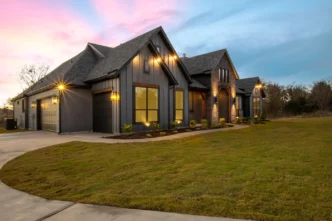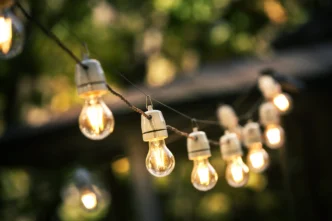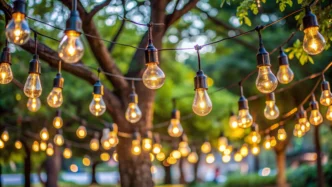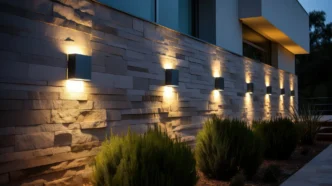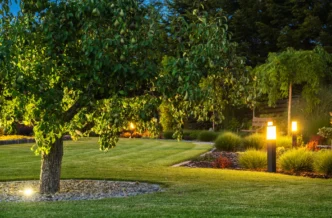Table of Contents: The Difference Between Lumen vs. Watt Comparison Guide
- What Are Watts?
- What Are Lumens?
- The Shift from Incandescent Watts to Modern Lighting
- Differentiating Between Lumen and Watt in Landscape Lighting
- The Difference Between Lumen and Watt FAQs
When it comes to landscape lighting, the terms “lumens” and “watts” get thrown around a lot and can be a bit confusing when determining the difference between lumen and watt to use in your home lighting. Our lumen vs. watt lighting comparison guide breaks down what each term means and how they impact your lighting choices.
Think of watts as a measure of how much energy your lights use, while lumens tell you how much light you actually get. They’re like the difference between knowing how much fuel you have in your car versus how far you can drive with it.
Grasping the difference between a lumen and a watt can totally transform how you light up your outdoor spaces, brightening your homemaking your home shine bright, boosting security, and highlighting your garden’s best features.
Read through these brilliant tips to make sure your setup looks amazing and runs efficiently.
What Are Watts?
For decades, people have associated watts with brightness. However, this understanding is a bit outdated.
Watts measure the amount of energy a light bulb consumes instead of the amount of light it produces. Traditionally, higher wattage always meant brighter light, but in the era of energy-efficient LED lighting, that’s no longer the case.
In landscape lighting, wattage is important because it affects your overall energy consumption and costs.
For example, incandescent or halogen bulbs typically have high wattages, meaning they draw more power and are less efficient. LED bulbs, on the other hand, require fewer watts to produce the same or even more light, significantly reducing energy costs while maintaining the desired level of illumination.
Why Watts Still Matter in Landscape Lighting
Understanding wattage remains vital when planning and maintaining a landscape lighting system. Here’s why it’s a key consideration:
- Energy Efficiency: Lower wattage typically translates to lower energy bills. You can significantly reduce wattage consumption by choosing LED bulbs without compromising brightness.
- Heat Management: High wattage often correlates with heat production, particularly in older incandescent or halogen bulbs. Minimizing wattage through LED lighting options reduces heat output for safe and functional property illumination.
- Power Supply: Depending on how many lights you plan to install, you need to ensure your system can handle the combined wattage without overloading circuits.
- System Longevity: Lower-wattage systems experience less wear and tear on components like transformers and cables. This contributes to a longer-lasting, more reliable setup, saving maintenance and replacement costs.
- Transformer Sizing: Landscape lighting often runs on low-voltage systems, meaning you must install a transformer to regulate the power. Knowing the wattage of each bulb helps ensure that your transformer can handle the total watt load of the entire lighting system.
What Are Lumens?
The relationship between watts and lumens is vital to understanding modern lighting efficiency. While watts tell you how much energy a light uses, lumens measure how much light it emits. The higher the lumen rating, the brighter the light. For example, a bulb with 800 lumens is twice as bright as one with 400 lumens, regardless of wattage.
This lumen-to-watt comparison becomes especially important when transitioning from traditional incandescent bulbs to energy-efficient LEDs.
In landscape lighting, lumens are the go-to metric when considering how much illumination you need in a particular area. Whether lighting a pathway, accenting a garden feature, or illuminating a driveway, understanding lumens will help you achieve the right ambiance and functionality. By focusing on lumens instead of incandescent bulb lumens per watt, you’ll find it easier to balance brightness with energy efficiency.
Lumens in Landscape Lighting
Lumens are integral in determining the brightness and functionality of your outdoor lighting system. Let’s explore how lumens can help determine the brightness of your outdoor lighting system:
- Pathway Lighting (100-200 Lumens): For subtle lighting that illuminates driveways and walkways without being overpowering, you’ll want fixtures that output between 100 and 200 lumens. This provides enough visibility for safety without making the space too bright or harsh. This level is bright enough to guide guests or vehicles without creating glare.
- Accent Lighting (200-300 Lumens): Highlighting trees, architectural features, or sculptures typically requires slightly higher lumen levels. Aim for 200 to 300 lumens to cast a soft, focused light that draws attention to specific areas without overpowering the natural beauty.
- Deck and Patio Lighting (300-500 Lumens): For entertaining areas, such as decks and patios, aim for fixtures with 300 to 500 lumens to ensure you have enough brightness for evening gatherings to strike a nice balance between practicality and ambiance—without any harshness.
- Flood Lights (700-1300 Lumens): Security or area lighting requires the highest lumens. Flood lights for driveways or large sections of your yard may range from 700 to 1300 lumens, depending on how much space you’re covering.
The Shift from Incandescent Watts to Modern Lighting
With the rise of energy-efficient lighting—mainly LEDs—the relationship between watts and lumens has shifted. A 60-watt incandescent bulb, for example, produces about 800 lumens. However, an LED bulb that produces 800 lumens might only consume 10 watts. This massive energy saving is why many homeowners are making the switch to LED landscape lighting.
The table below shows the incandescent and LED watt differences and how LED technology allows for more light output (lumens) with less energy consumption (watts), offering a practical advantage for outdoor and landscape lighting.
| Light Bulb Type | Lumens | Watts (Incandescent) | Watts (LED) |
| Path Lighting | 100 | 15 | 1-3 |
| Accent Lighting | 300 | 40 | 4-5 |
| Flood Lighting | 1000 | 75 | 12-14 |
Why Lumens Are Key to Landscape Lighting
For landscape lighting, planning based on the desired light output rather than energy consumption is crucial. Here’s why focusing on lumens makes sense:
- Precision in Design: With lumens, you can fine-tune your lighting setup to achieve the perfect balance. Whether you want to create a soft, romantic atmosphere in your garden or a brightly lit driveway for safety, lumens accurately measure brightness.
- Avoid Over-Lighting: It’s easy to think that more light is better, but too much brightness can overwhelm a space and diminish the mood. Focusing on lumens helps prevent over-lighting your landscape, ensuring each area gets the right amount of light for its intended purpose.
- Energy Efficiency: By shifting the focus from watts to lumens, you can design a lighting system that is not only functional but also cost-effective. LED bulbs with high lumen output and low wattage are a win-win, delivering excellent lighting performance while keeping your energy bills in check.
Making the Right Choice: LED Lighting and the Lumens-to-Watts Ratio
Understanding incandescent light bulb watts to lumens in modern lighting helps highlight the advantages of switching to LEDs. Choosing LED bulbs is often the best route when planning your landscape lighting system. Not only do they offer higher lumens at lower wattages, but they also have longer lifespans and can withstand harsh weather conditions. Additionally, LEDs offer flexibility in color temperature, allowing you to choose between warm, cool, or daylight tones to suit your space.
To optimize your watt-to-lumen landscape lighting:
- Calculate the lumens you need based on the space and purpose.
- Choose LED fixtures to minimize energy consumption.
- Ensure your transformer can handle the total wattage of your setup.
Differentiating Between Lumen and Watt in Landscape Lighting
Lumens are the new watts in landscape lighting. While watts are still important for energy consumption, lumens are the key to getting the right brightness for each outdoor space. Understanding the relationship between lumens and watts allows you to create a beautifully lit landscape that enhances your home’s aesthetic, boosts safety, and remains energy-efficient. Want to keep learning? Read our guide on the difference between watts and amps.
Focus on lumens for brightness, choose energy-saving LEDs for efficiency, and ensure your setup is ideally suited to your landscape needs. Your yard—and your electric bill—will thank you!
The Difference Between Lumen and Watt FAQs
How bright is 200 lumens in watts?
The brightness of 200 lumens depends on the type of bulb. With traditional incandescent lighting, 200 lumens would require about 25 watts. However, with energy-efficient LED bulbs, 200 lumens typically only use around 3 watts, making LEDs a far more efficient choice for producing the same brightness level.
How many lumens is a 60-watt bulb?
A 60-watt incandescent bulb produces approximately 800 lumens. An LED bulb that produces 800 lumens would only use around 8–10 watts. Again, this illustrates the significant energy savings possible with modern LED lighting technology.
What is the brightest light bulb?
The brightness of a bulb is measured in lumens rather than watts. Some of the brightest light bulbs are high-output LEDs, producing upwards of 20,000 lumens. These are most commonly used for industrial or outdoor applications. LED floodlights can reach 1,500–5,000 lumens, producing adequate safety and efficiency for residential use.
Join our Insider list and check out the different landscape lighting options that we have to offer.
